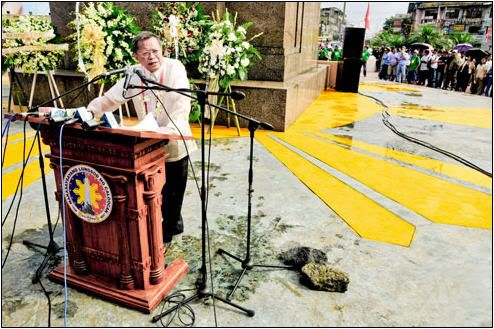H1N1 Update No. 40 - Duque Outlines Mitigation Strategies Against A (H1N1); 6 More Fully Recovered Patients Sent Home Today
13 June 2009
Health Secretary Francisco T. Duque III today informed the public that the Department of Health (DOH) is soon shifting to a policy of mitigation in response to the decision of the World Health Organization to raise the Pandemic Alert Level 5 to Level 6.
“A policy of mitigation means that the DOH will shift focus in preparing households and health facilities to respond to the challenge posed by A (H1N1) in anticipation of more confirmed cases,” Duque said.
“This means that we have to make sure that our health system is equipped to treat and manage particularly severe cases which may require more intensive care in our hospitals and that mild cases are appropriately treated at home,” he added.
Under Pandemic Alert Level 6, WHO has alerted all countries that the A H1N1) virus is now widespread in at least two WHO regions and that further spread is inevitable. As a logical response, WHO advised all its member states to focus on the appropriate management of patients, particularly those at high risk for developing flu complications and a decreased emphasis on stopping the spread of the virus.
In a press conference held this afternoon, Duque presented the DOH’s Strategic Plan and stepwise approach for the country’s mitigation response to the novel Influenza A virus. The stepwise approach consists of four phases according to the number of cases and the presence of community level transmission in a certain locality.
The mitigation approach also outlines key management imperatives in the areas of activating the command system, surveillance, health facility response, public health interventions and risk communication strategies.
“I want to make it clear that mitigation will be done in phases and that it will not be applied across the nation completely and instantaneously. This will depend on the presence of community-wide transmission and whether there is a high or low volume of cases in a community. Therefore, in areas where there are few cases and we can still contain the spread of A (H1N1), mitigation strategies generally will not apply,” Duque said.
Duque also made clear that with the mitigation strategy, the DOH will now concentrate on promptly giving care to populations found to be at high risk for developing flu complications based on the epidemiology being shown by the A (H1N1) locally and in many other affected countries thus far.
“This virus, as explained by WHO, causes very mild symptoms and a self-limiting course in the overwhelming majority of patients largely those who have no preexisting conditions. We need to focus on giving more attention and care to patients with preexisting diseases like diabetes, heart and renal disease, immmunocompromised state, the pregnant, the very young and the elderly and those with infections like HIV/AIDs and TB. We advise these patients to immediately consult their doctors as soon as they develop flu-like symptoms,” Duque said.
Duque said that the DOH will continue to monitor geographic spread and severity of illness to determine application of mitigation measures on a case to case basis.
Thus, with the policy shift, DOH will be implementing a change in its criteria for hospital admission and giving of antiviral treatment and prophylaxis.
“Only those with progressive symptoms and preexisting conditions will be hospitalized and will be given antivirals immediately. For the majority of cases we expect to be mild, they will only have to be put under home treatment and they will be advised regarding supportive care and to observe social distancing for 10 days,” Duque said.
Duque also reported today 19 new cases, all mild in nature. Eleven of these new cases are males, the other 8 are females. The age range of these cases is from 6-49 years old. All but one of the 19 are Filipinos. These new additional cases bring the total count to 111.
Duque announced that 6 more fully recovered patients have been sent home today thus, bringing the total count of recovered A (H1N1) cases to 38.
“So far the country has no reported case of death or severe illness in all of the 111 documented positive cases,” Duque stressed.
In their latest report dated June 12, the WHO has reported 29,669 cases and 145 deaths from 74 reporting countries.
GOD BLESS YOU PRESIDENT CORY!
Monday, June 15, 2009
June 15, 2009 — H1N1 Confirmed Cases in the Philippines Now at 147 — The DOH Should Make Sure It Regularly Updates its H1N1 Info on its Website
15 June 2009 12:55pm
It's now June 15, 2009, 12:55pm as I post this article but the latest update posted at the DOH website about H1N1 is as of June 13, 2009.
I understand that there are already 147 confirmed H1N1 cases as of yesteday, June 14, Sunday.
Why is the DOH getting slack in its reporting of H1N1?
Here's H1N1 Update No. 40 from the DOH website:
end
Subscribe to:
Post Comments (Atom)
















No comments:
Post a Comment
If you encounter any problem posting your comment, such as the error message "Your request could not be processed. Please try again," the problem might be resolved simply by trying to resubmit the comment. Otherwise, please email me at rollyocampo@yahoo.com. Thanks a lot for visiting my blog. Have a nice day and God bless!